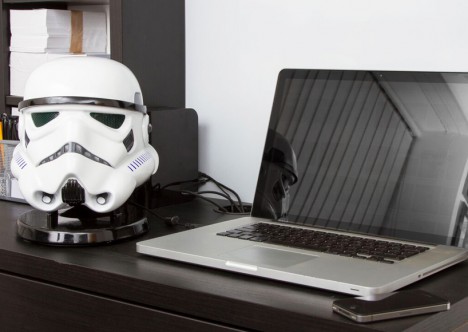$ (document).ready(function() { SampleGalleryV2({“containerId”:”embeddedSampleGallery_0864934377″,”galleryId”:”0864934377″,”isEmbeddedWidget”:true,”selectedImageIndex”:0,”isMobile”:false}) });
Amid the wares DJI introduced at NAB 2018 this week are a pair of professional gimbal control tools designed for “every level of filmmaker and scenario.” Called the Master Wheels and Force Pro, these two DJI products are built to control the company’s Ronin 2 and Ronin-S gimbals, offering high precision control and hoping to simplify the shooting of complex and/or fast-moving scenes.
DJI Master Wheels
Master Wheels is a control device that adjusts gimbal movements using a trio of weighted wheels. These wheels control roll, pan, and tilt in part using ultra-high-res optical encoders capable of detecting “the subtlest” adjustments, DJI explains. Each wheel’s angle can be adjusted, and the wheels can also be detached.
Master Wheels supports both 2.4GHz and 5GHz wireless transmission and has an operating distance of more than 1.9 miles / 3km. Latency is as low as 10ms, and users have the option of detaching the wireless transmitter to remotely mount it with a 5m / 16ft cord, providing a stronger signal.
Other features include dials to control dampening, speed, and smoothness, support for 1/4″ and 3/8″ accessories, and a dedicated Mitchell mount on the main console’s base.
DJI Force Pro
The other product announced at NAB 2018, Force Pro, enables users to remotely control gimbals via a 2.4GHz/5GHz wireless transmission system and DJI’s remote control tech. Force Pro also offers latency as low as 10ms, plus a CANBUS cable physical tether with a 200Hz signal for avoiding interference issues.
The control tool also features a built-in Inertial Measurement Unit (IMU) and compass that work together to prevent gimbal drifting and improve movement precision. Force Pro features up to 5 hours of battery life and supports recharging using the CANBUS port, USB-C, and a DC-in port.
According to DJI, users unfamiliar with more complex systems, such as Master Wheels, can “quickly become proficient” with a product like the Force Pro. To improve efficiency, DJI offers an optional handlebar, which itself can be used to mount accessories including thumb controllers and monitors.
Availability
Both Master Wheels and Force Pro are available to preorder now from DJI flagship stores and authorized pro dealers, though shipping doesn’t start until June. Master Wheels is offered in three variants: a single wheel control module for $ 2,500, a 2-axis model for $ 6,000, and a 3-axis model for $ 8,000. Force Pro costs $ 1,200.
To learn more about either of these gimbal controllers, head over to the DJI website.
Press Release
DJI Reveals New Filmmaking Tools at NAB 2018, Providing Professional Gimbal Control Solutions For Every Level of Filmmaker
DJI Reveals New Filmmaking Tools at NAB 2018, Providing Professional Gimbal Control Solutions For Every Level of Filmmaker
DJI Master Wheels And Force Pro Offer Precise And Intuitive Control Over Gimbals
DJI, the world’s leader in creative camera technology, introduced new cinema grade tools at NAB 2018 with DJI Master Wheelsand DJI Force Pro that offer professional gimbal control solutions for every type of filmmaker and scenario. Built to deliver precise gimbal movements, these new products offer filmmakers reliable tools that help capture complex shots with ease while adding a cinematic quality to any scene. Master Wheels and Force Pro control DJI’s Ronin 2 and Ronin-S gimbals, expanding the creative possibilities for cinematographers of varying experience levels.
- Master Wheels: A professional level, high-precision gimbal control system that applies a 3-wheeled form to control pan, tilt and roll. Smooth, stable and precise movements create a professional look, while an easy to use and functional design make filming complex footage simpler.
- Force Pro: A motion sensing system that uses DJI’s industry-leading remote-control technology to precisely synchronize the movement of Force Pro with the gimbal, helping capture cinematic scenes with ease. Intuitive and easy to learn, Force Pro breaks down the barriers that come with understanding the operation of more complex gimbal control systems.
“Creating these gimbal systems demonstrates our dedication to every level of filmmaker, whether you are an amateur just beginning your journey or a seasoned veteran with decades of experience,” said Paul Pan, Senior Product Manager at DJI. “Force Pro offers simplicity and functionality for filmmakers seeking a more intuitive tool, and Master Wheels brings the highest degree of precision control when working with a gimbal setup.”
Master Wheels – Bring Precise Control To Your Scene
DJI Master Wheels are a high-precision gimbal movement tool that utilizes three weighted wheels to adjust pan, tilt and roll with extreme accuracy. Ultra-high resolution optical encoders detect the subtlest of wheel adjustments while complex algorithms translate that movement to enhance the level of accuracy of the gimbal. Master Wheels employ the latest sensor positioning technology along with dual-band low-latency 2.4/5.8GHz wireless transmission technology to ensure a stable and reliable connection from the main console to the moving rig with a latency as low as 10 milliseconds and an operating distance of over 1.9 miles.
Crafted for efficiency and ease of use, Master Wheels have an intuitive user interface offering quick access to gimbal settings along with the status of equipment. Three user customizable buttons offer the ability to save shortcuts while on-board motion capture storage enables the filmmaker to easily repeat the motion of the rig, allowing filmmakers to dedicate their attention to other aspects of the scene such as the actresses and actors. Built-in three-stop switches are capable of adjusting direction for each axis while dials manipulate speed, smoothness and dampening. Additionally, Master Wheels can change vital camera settings from the main console for a rapid response to any modifications an operator might need to make.
A modular design makes Master Wheels functional and versatile, helping to achieve the shot, no matter the situation. The three stainless steel wheels and the control modules have the ability to be swiftly detached from the main console and connected with a wire for space constrained shooting situations. The wireless transmitter can also be detached and remotely mounted via a 5-meter cord in order to gain a stronger signal when needed.
Filmmakers have the flexibility to attach various accessories using multiple 1/4” and 3/8” threads located on the main console such as external monitors. For added comfort during operation, the angle of one control module can be manually adjusted based on the preference of the user. Master Wheels can be mounted on a variety of platforms including inside vehicles, tripods and more with a dedicated Mitchell mount on the base of the main console.
Compatibility with an ecosystem of DJI products, as well as support for third-party gimbals, broaden the versatility of Master Wheels on set. Operators can direct gimbal movements using DJI’s professional products including the Ronin 2 and Ronin-S, taking full advantage of the latest in gimbal technology. DJI TB50 intelligent batteries, the same model used on the Ronin 2 and Inspire 2, power the system for up to 18 hours. For filmmakers with non-DJI equipment, Master Wheels support various third-party gimbals and can be powered through the DC-IN port to utilize V-Lock batteries from third-party manufacturers.
Force Pro – Natural Movements Through Intuitive Design
Utilizing DJI’s state-of-the-art remote-control technology, Force Pro precisely synchronizes the movement of the operator with the movement the gimbal, helping capture smooth imagery even in complex or fast-moving scenes. An embedded compass and Inertial Measurement Unit (IMU) work in tandem to ensure precise movement and prevent the gimbal from drifting to maintain a consistent frame. Its low-latency dual-band 2.4/5.8GHz wireless transmission system offers near real-time control with a communication latency as low as 10 milliseconds. Force Pro can also be physically tethered to the gimbal using a CANBUS cable touting a 200Hz signal to eliminate any chance of connection interference while on set.
Designed for ease of use, Force Pro is an intuitive tool that filmmakers will quickly become proficient using, even with minimal familiarity operating gimbal control systems. Those lacking experience working with more complex products such as Master Wheels or even joysticks, the operation of Force Pro is quickly understood, breaking down barriers that come with using more advanced equipment on set. An optional lightweight handlebar adds to the efficiency of Force Pro, offering a total solution for handheld operation with the ability to mount various accessories to the handlebar, including monitors, video transmission systems, and thumb controllers. Operators can conveniently set two custom speed profiles and a built-in ultra-bright OLED screen provides equipment status along with the ability to control gimbal and camera settings for fast adjustments to a changing scene.
Force Pro is compatible with DJI Ronin 2 and Ronin-S gimbals along with other third-party systems. Operators can rely on Force Pro during extended film shoots with a battery life of up to 5 hours when fully charged, and recharging can be achieved several ways, via the USB-C, CANBUS port, or the built-in DC-IN port compatible with third-party V-Lock batteries.
Price and Availability
Master Wheels will be available for pre-order on April 10th, 2018 at authorized pro dealers or through DJI flagship stores. The complete 3-Axis Model will retail for $ 8,000 USD, 2-Axis Model for $ 6,000 USD and Single Wheel Control Module for $ 2,500 USD. Master Wheels will begin shipping in June 2018. For more information on all the new features and capabilities of Master Wheels, please visit www.DJI.com/Master-Wheels.
DJI Force Pro will be available for pre-order on April 10th, 2018 at authorized pro dealers or through DJI flagship stores. Retail cost will be $ 1,200 USD and will start shipping in June 2018. For more information on all the new features and capabilities of Force Pro, please visit www.DJI.com/Force-Pro.
Articles: Digital Photography Review (dpreview.com)




























You must be logged in to post a comment.